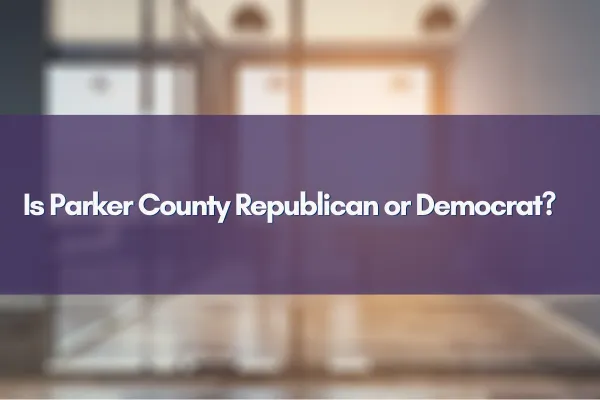BLOG

Is Parker County Republican or Democrat?
Is Parker County Republican or Democrat?
How do you know if a place leans red or blue? Is Parker County Republican or Democrat? Spoiler alert: This Texas county is about as solidly red as a Lone Star sunset in July. But let’s unpack the story, the data, and sprinkle in some storytelling magic — imagine Steve Jobs narrating politics, with Neil Patel handling SEO. Ready? Let’s dive in.
Setting the Stage: Where is Parker County, TX?
Nestled just west of the Dallas-Fort Worth Metroplex, Parker County, TX, isn't a sleepy backwater but an evolving suburban county. It was established in 1856 and named after Isaac Parker, a Texas legislator. The county seat and largest city is Weatherford, and the area covers a sprawling 910 square miles of Texas terrain.
According to the 2020 U.S. Census, Parker County had a population of over 148,000—which has steadily grown to an estimated 173,000+ in 2023. The demographic composition still skews predominantly non-Hispanic white (around 80% as of 2023) with a Hispanic or Latino population growing to approximately 15%.
But this blog isn’t just about demographics or Geography 101. It's about politics. So, buckle up.
The Political Pulse: Republican or Democrat?
Quick Answer:
Is Parker County Republican or Democrat? Parker County, TX, is a Republican stronghold — and it hasn’t voted for a Democratic presidential candidate since 1976. Republicans have held all public offices since 1999.
In 2024, Republican candidates amassed over 82% of the vote in presidential elections here, with Democrats trailing at about 16%.
That’s a landslide, folks.
The Long-Term View: A GOP Fortress
Since the late 20th century, Parker County has been unwaveringly red. The Republican Party dominates both state and national elections in this area. Here’s a quick rundown of voting patterns:
Presidential Elections: Democrats haven’t won since 1976, when Jimmy Carter carried the county.
Recent Results: Donald Trump, in 2020 and 2016, eclipsed 80% of the vote.
Republican Hold: All public offices, from county commissioners to local judgeships, have been Republican-held since the late 1990s.
In fact, look at the very recent election returns:
Year Republican Vote Democratic Vote
2024 82.75% 16.37%
2020 81.50% 17.10%
2016 81.79% 14.69%
If political parties were sports teams, Parker County is the Dallas Cowboys of conservative Texas: popular, consistent, and hard to beat.
Why So Republican? Key Influences
This leads us to an important question: Why has Parker County, TX, stayed red even when Texas is seeing demographic shifts?
1. Suburban Conservatism
Like many suburban counties in the Dallas-Fort Worth metroplex, Parker County is a mix of traditional rural values meshed with growing suburban development. These areas tend to lean conservative for reasons including:
Preference for lower taxes
Business-friendly policies
Conservative social values
2. Demographics Matter
79.6% of residents identify as non-Hispanic white (2023 estimates)
Hispanic or Latino population is growing but still around 15%
Demographic trends can sometimes predict political outcomes. Although the Hispanic population is increasing, it hasn’t yet shifted the political balance substantially—the GOP's foothold remains firm here.
3. Political Engagement & Office Holders
The Republican Party has consistently held all county offices since 1999, indicating strong grassroots organization and voter turnout on the conservative side.
4. Texas's Larger Political Landscape
Texas as a whole is a battleground, but the urban centers like Austin, Houston, and Dallas lean Democratic, while counties like Parker stay reliably Republican. It’s the classic city-suburb divide in a nutshell.
The Data-Powered Reality
Numbers don’t lie. Here are some nuggets to help cement the picture:
In the 2024 U.S. Senate race in Parker County, Republican candidates swept nearly 80% of the vote.
Between 2000 and 2020, Parker County’s population surged from under 90,000 to over 148,000, yet the political landscape remained consistent.
The county’s Hispanic population grew from 7% in 2000 to over 13% in 2020, yet the county still returned Republican majorities — a sign of the complex voting behaviors in suburban Texas.
A Quick FAQ: Parker County’s Political Identity
1. Is Parker County Republican or Democrat?
Parker County is decidedly Republican and has been for decades.
2. Do Democrats have any foothold in Parker County?
Democrats receive around 15-20% of the vote in recent elections, but have not won major races here in decades.
3. Has Parker County ever voted Democrat recently?
Not since 1976 in presidential elections.
4. Is Parker County growing politically diverse due to demographic shifts?
It is growing demographically but political shifts toward Democrats have been minimal so far.
5. Where can I learn more about schools in Parker County?
Schools are located in several districts; for detailed, non-biased info, check GreatSchools.org.
No Politics Without People: Notable Personalities
Parker County has history and character. It’s the hometown or stomping ground of notable figures like:
Oliver Loving, pioneer cattleman
Mary Martin, famous stage and screen actress
Jim Wright, former Speaker of the U.S. House and Weatherford mayor
Such personalities reflect a strong local heritage, intertwined with values often aligned with conservative politics.
What This Means for Residents and Visitors
Whether you're considering moving to Parker County, working here, or just curious—knowing that it is a Republican stronghold can help you understand the local political climate and community preferences.
It’s a place where traditions hold strong but growth is rapid.
Final Thoughts from Your Friendly Neighborhood SEO + Story Guide
In the words of Steve Jobs, "You can’t connect the dots looking forward; you can only connect them looking backward." What we see in Parker County, TX, today is a political landscape shaped by decades of demographic trends, cultural values, and economic growth.
And like any great product launch, the secret sauce lies in understanding your audience intensely—and Parker County clearly knows its brand.
So, if you’re Googling "Is Parker County Republican or Democrat?" the data is clear: Parker County, TX, has been, is, and likely will remain a Republican stronghold for years to come.
Engage With Us!
Did this article clear up your questions about Parker County’s political identity? Think the data is surprising or just what you expected? Drop a comment below, share this post with friends curious about Texas politics, or reach out for more local insights.
📞 Contact: Kelli Boyd
📍 Title: Realtor
📲 Phone: 817-374-5151
📧 Email: kelli.boyd@williamstrew.com
🌐 Website: https://kelliboydrealtor.com
This blog post is based on publicly available information from the U.S. Census Bureau and respected sources like Wikipedia and election data. It aims to provide neutral and fact-based insights regarding Parker County’s political leanings, while complying with all applicable fair housing and advertising laws.





